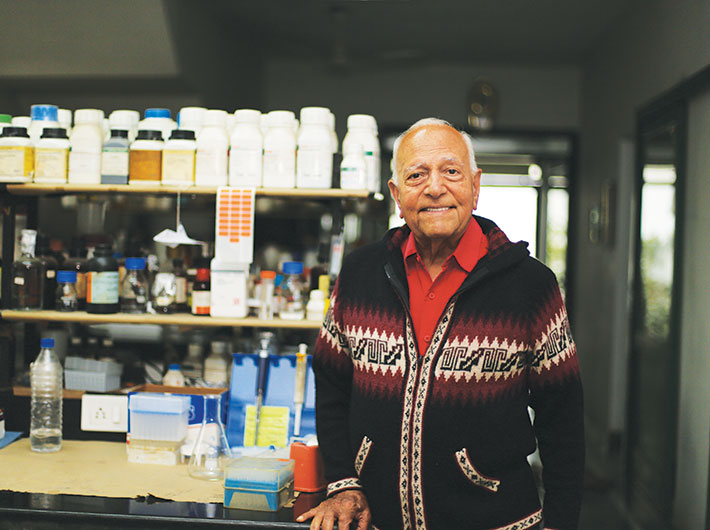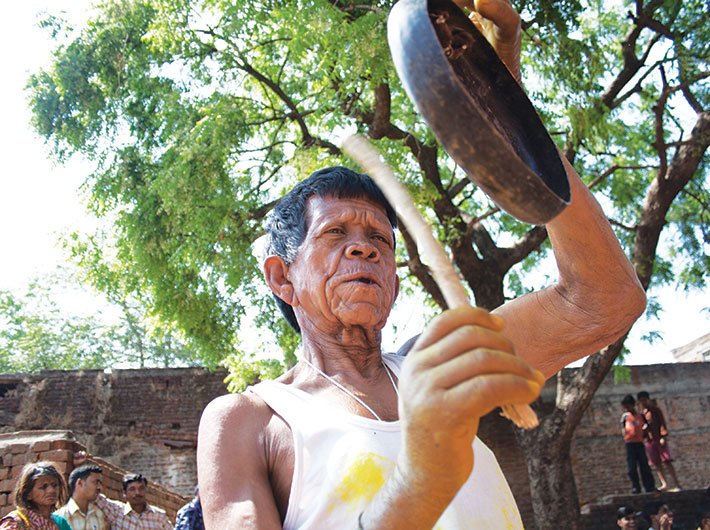After more than 12 years of lying in the freezer, Dr GP Talwar’s vaccine is brought out to do battle against the disease. Thereby hangs a tale...
Twelve years after announcing the elimination of leprosy, the government is undertaking a massive vaccination drive against the disease. That slow about-turn is the culmination of a rush to meet a statistical goal and, in the process, the casting aside of the creation of a Padma Bhushan awardee.
Dr GP Talwar, a sprightly 91 years, keeps a regular 10-to-6 schedule at the Immunology Foundation, in Neb Sarai, Delhi. It’s an independent not-for-profit, where he directs doctoral and post-doctoral work. He compliments women researchers with “You’re looking good” and keeps the spirit and energy high in the labs. Discoveries in the biological sciences are usually the result of painstaking and time-consuming work, rather than the aha insights of physics or maths. So a large part of a mentor’s job is to sustain researchers’ interest as they plough on. One peak of Talwar’s career, the anti-leprosy vaccine, took about 25 years of work.
“In 1969-70, when I was at the All-India Institute of Medical Sciences (AIIMS), the World Health Organisation (WHO) approached me to work on a vaccine against leprosy,” says Dr Talwar, who later became the founding director of the National Institute of Immunology (NII), Delhi.
With his team, Dr Talwar collected 16 samples of bacteria to see if any of them might counter the effects of Mycobacterium leprae, the organism that causes leprosy (also known as Hansen’s disease). What they needed to find was a species of bacterium that would be non-pathogenic and human-friendly. At the same time, it had to stimulate the production of antibodies that would prevent infection with M. leprae.
In the end, they zeroed in on such a bacteria, but it was an undocumented species. “There was no record available about it in the World Data Bank, so we just coded it Mw,” says Dr Talwar. “Later, we arrived at a nomenclature for it – Mycobacterium indicus pranii – or MiP, in short. Indicus stands for India, Pran is for my middle name, and ‘nii’ for the National Institute of Immunology. We conducted clinical trials and saw that the vaccine was effective and accelerated multi-drug therapy in patients. It cured lesions and wounds remarkably.”
By 2004, the NII had carried out field trials on 24,000 subjects and the results were encouraging. Eventually, the vaccine was approved by the Drugs Controller General of India (DCGI) and the US Food and Drug Administration (USFDA). It’s being manufactured and marketed by Cadila, an Indian pharma giant. A shot costs Rs 15,000.
But the idea of vaccinating vulnerable groups – essentially family members of leprosy patients, or those who would come in close contact with them – never entered the government’s public health policy. “Perhaps there was no will to do so,” says Dr Talwar. “When we approached the NLEP [National Leprosy Eradication Programme] in 2004, suggesting vaccination against leprosy, health officials rejected the idea. They said a vaccination programme would require training of staff at massive level. Also, leprosy patients and their families would have to come out in public for immunisation. At that time, we were also nearing the WHO elimination status [for leprosy] and everyone was in celebratory mood.”
Interview with Dr GP Talwar, immunologist, founder director NII, inventor of leprosy vaccine

How is your vaccine different from Bacillus Calmette-Guérin (BCG), which is said to have a protective effect against leprosy?
BCG is not fully protective, unlike MiP. For example, in Bangladesh, BCG was used to immunise close contacts of leprosy patients, however, 23 percent contacts developed leprosy only two-three months after the vaccination. This might have happened because BCG is active only when it is live, whereas MiP retains efficacy in killed state. Also, there is a genetic barrier to the action of the BCG vaccine. For example, it works in Uganda, but doesn’t work in South India.
How effective is your vaccine?
It is 100 percent effective. It accelerates bacterial clearance and shortens recovery time. It is also effective in patients who are slow responders to multi-drug therapy. Immunisation with MiP not only cures patients faster, it protects them from relapse and further spreading the disease. It improves the ugly, defacing lesions of leprosy patients. These are seldom improved by treatment with multi-drug therapy alone.
Apart from immunising a person, another remarkable feature of the MiP vaccine is the conversion of 65 to 69 percent of patients from lepromin negativity to lepromin positivity status. Patients treated with MDT remain lepromin negative and susceptible to the disease on re-exposure to M. leprae. The vaccine also clears bacilli from the peripheral nerves.
How should the government’s immunisation programme work to eradicate leprosy with this vaccine?
Eradication of leprosy demands immunisation of not only the patient, but all members of his family and close contacts. This was the way smallpox was eradicated. It seems like a huge undertaking, but is a much smaller than tackling polio. It will be a historic achievement.
Are there other uses for the MiP vaccine?
It shares antigens with both M. leprae and M. tuberculosis and is being used for immunotherapy of category II ‘difficult to treat’ tuberculosis patients as well. Besides leprosy and tuberculosis, the MiP vaccine has proved to be a potent invigorator of both cellular and humoral immune responses. It has cured anogenital warts. It is being used in cancer cases such as myelomas.
Was the vaccine available in the market all these years?
Yes, it was available, but the government never took note of it until recently. It is licensed to Cadila Pharma, Ahmedabad.
Elimination vs reality
In 1991, the World Health Assembly, the decision-making body of the WHO, resolved to eliminate leprosy worldwide by 2000. So how is ‘elimination’ of a disease such as leprosy achieved? In the 1980s, it was noticed that leprosy rates were declining in countries where it was prevalent. The thinking was that as rates declined, health personnel would be able to focus their efforts more and that this would eventually lead to eradication. The prevalence rate at which experts thought this tightening of the noose would occur was one case per 10,000 people. It was on this rate – later questioned as arbitrary – that the World Health Assembly settled.
At that time, the number of leprosy cases worldwide was 6.13 lakh, of which 5.17 lakh were in India. With the highest incidence in the world, the burden on India was maximum. Statistically, India achieved ‘elimination’ status in 2005. But even then, the country was home to 60 percent of the world’s leprosy patients – out of 2.99 lakh cases worldwide, 1.69 lakh were in India.
“What happened after that is surprising,” says Dr Arvind Singh, a senior health official from Uttar Pradesh who has worked on leprosy for over two decades. “The NLEP was subsumed under the National Rural Health Mission (NRHM). Door-to-door screening and identification was stopped. Health workers trained for leprosy screening were unofficially shifted to other departments. Vehicles used by leprosy officials and health workers were diverted for other work. Case detection went into passive mode. In a nutshell, leprosy wasn’t being taken seriously.”
The only way new cases, if any, could be counted was if patients voluntarily came to district, divisional or private hospitals. Experts like Singh reckon that, since 2005, several new cases have remained undetected. The disease might have been ‘eliminated’ statistically, but on zooming in to the district and block level, the figures were still alarming.
Waking up again
Last year, the government restarted door-to-door screening for leprosy, admitting that leprosy rates are shockingly high at the hyper-local level. Says Dr Anil Kumar of the NLEP, “In September 2016, we found 1.27 lakh new cases in 168 districts, each with a population of 3 lakh or above. Before this, there were 86,026 cases on record as of March 2016. Chhattisgarh and Dadra and Nagar Haveli never achieved the elimination levels. In addition, Delhi, Lakshadweep, Chandigarh and Odisha, which had earlier achieved the elimination level, are now showing an increase in prevalence rate.”
Indeed, in close focus, a reversal was to be seen. From 1985 to 2005, the numbers of cases had declined steadily. From 2005 to 2016, during which there was no active search, the prevalence rate has remained steady. It has even risen at many places where the disease is endemic. When the NLEP researched last year, it found that due to late detection, cases of leprosy-inflicted disability and disfigurement shot up from 3,015 cases in 2005 to nearly 6,000 cases in 2016.
“The screening drive conducted last year was the largest in NLEP’s history,” says Dr Anil Kumar. This underlines the seriousness of the problems created by doing away with door-to-door screening since 2005. “Our focus is on the early detection and treatment of the disease so that disability gets controlled.”
A Leprosy Case Detection Campaign (LCDC), on the lines of the anti-polio campaign has been launched. Committees at the national, state, district and block levels have been formed to supervise door-to-door screening. Suspect cases are put through diagnostic tests to confirm leprosy. The health ministry is also thinking of using a new combination drug, along with multi-drug therapy, for more effective treatment.
“We can’t set a deadline, saying leprosy will be eradicated in such and such year,” says Dr Anil Kumar. “This is because the incubation period of the disease can go up to 10-15 years. Thus, we need to follow the approach we have reintroduced.”
Dr Talwar redux
Along with screening, the NLEP has decided to conduct a vaccination drive, under which patients’ relatives and those living in proximity to them will be inoculated. So after being out in the cold, Dr Talwar’s vaccine is being recalled to do battle, one it should have been put to 13 years ago. The vaccine will be launched in six districts of Gujarat and Bihar, two of the 19 states where the disease is endemic. The districts being covered in Gujarat are Narmada, Tapi, Navsari, and Bharuch, in the forested southern part of the state. The districts being covered in Bihar are Banka and Jamui, both to the south of the state and in the Bhagalpur division. Since this is a government programme, the vaccine will be administered free.
This brings hope to the families of patients like Jai Narayan, who was diagnosed with leprosy in 2015, when he was in Delhi, working as a cycle-rickshaw puller. He was forced to return to Jamui with his wife and two children, and the family had to take up residence in a lepers colony on the outskirts of the town. For two years, he suffered the humiliation of social isolation, all the while haunted by the fear that his children might contract the disease. Learning of the vaccination programme, he said he could not believe his ears. To him it seemed like magic.
Dr Talwar, scientist to the core, is happy about the revival of his vaccine, but remains stoical about the fact that it was ignored for so long. “The past is past,” he says. “But let something good come of it in future.”
swati@governancenow.com
(The story appears in the April 1-15, 2017 issue of Governance Now)

